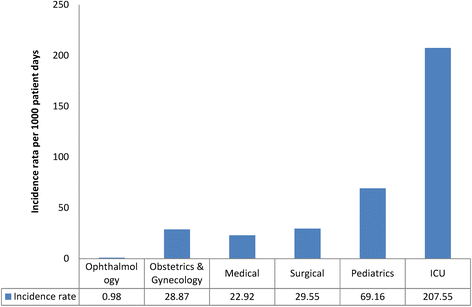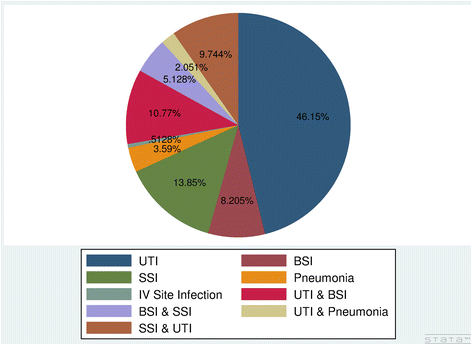Healthcare associated infection and its risk factors among patients admitted to a tertiary hospital in Ethiopia: longitudinal study
- PMID: 29312659
- PMCID: PMC5755436
- DOI: 10.1186/s13756-017-0298-5
Healthcare associated infection and its risk factors among patients admitted to a tertiary hospital in Ethiopia: longitudinal study
Abstract
Background: Healthcare associated infection (HAI) is alarmingly increasing in low income settings. In Ethiopia, the burden of HAI is still not well described.
Methods: Longitudinal study was conducted from May to September, 2016. All wards of Jimma University Medical Centre were included. The incidence, prevalence and risk factors of healthcare associated infection were determined. A total of 1015 admitted patients were followed throughout their hospital stay. Biological specimens were collected from all patients suspected to have hospital aquired infection. The specimens were processed by standard microbiological methods to isolate and identify bacteria etiology. Clinical and laboratory data were collected using structured case report formats.
Results: The incidence rate of hospital acquired infection was 28.15 [95% C.I:24.40,32.30] per 1000 patient days while the overall prevalence was 19.41% (95% C.I: (16.97-21.85). The highest incidence of HAI was seen in intensive care unit [207.55 (95% C.I:133.40,309.1) per 1000 patient days] and the lowest incidence was reported from ophthalmology ward [0.98 (95% C.I: 0.05,4.90) per 1000patient days]. Among patients who underwent surgical procedure, the risk of HAI was found to be high in those with history of previous hospitalization (ARR = 1.65, 95% C.I:1.07, 2.54). On the other hand, young adults (18 to 30-year-old) had lower risk of developing HAI (ARR = 0.54 95% C.I: 0.32,0.93) Likewise, among non-surgical care groups, the risk of HAI was found to be high in patients with chest tube (ARR = 4.14, 95% C.I: 2.30,7.46), on mechanical ventilation (ARR = 1.99, 95% C.I: 1.06,3.74) and with underlying disease (ARR = 2.01, 95% C.I: 1.33,3.04). Furthermore, hospital aquired infection at the hosoital was associated with prolonged hospital stay [6.3 more days, 95% C.I: (5.16,7.48), t = 0.000] and increased in hospital mortality (AOR, 2.23, 95% CI:1.15,4.29).
Conclusion: This study revealed high burden and poor discharge outcomes of healthcare associated infection at Jimma University Medical Centre. There is a difference in risk factors between patients with and without surgery. Hence, any effort to control the observed high burden of HAI at the hospital should consider these differences for better positive out put.
Keywords: Africa; Ethiopia; Health-care associated infection; Jimma; Nosocomial infection.
Conflict of interest statement
Ethical clearance and approval was obtained from college of health science Institutional Review Board of Jimma University under reference number RPGe/355/2016. Written informed consent prepared in local languages (Afaan Oromo and Amharic) was obtained from all participants or care givers in case patient was not able to consent. Objectives, procedures, risks and benefits of the study were described to all participants before collecting data and specimens from them. Laboratory findings were swiftly communicated to treating physician for urgent intervention.Not applicable – This manuscript does not contain any individual person’s data.The authors declare that they have no competing interests.Springer Nature remains neutral with regard to jurisdictional claims in published maps and institutional affiliations.
Figures


References
Publication types
MeSH terms
LinkOut - more resources
Full Text Sources
Other Literature Sources

